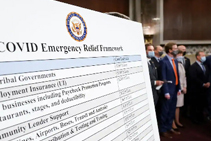
Dear Industry Associations
OK, folks, we made it to 2021! There is good news on the horizon that things will get moving again at a sustainable pace later this year. While we’re all contending with new lockdowns and record COVID numbers, there is, for the first time in a long time, an actual light at the end of the tunnel.
Before we move on from the sh*tshow that was 2020, we’d like to recognize and thank the numerous industry associations that came together last year in an unprecedented effort to fight like hell for you and your business. National associations such as the National Limousine Association, Global Business Travel Association, United Motorcoach Association, American Bus Association, and The Transportation Alliance banded together with organizations representing travel and tourism to keep the pressure on and give us a voice in Congress. That dedication helped to ensure that our industry was included and taken care of with much-needed funds. This unity across the U.S. travel spectrum was awe-inspiring—and the best part of 2020. Thank you.
Local associations: We love and thank you too. You helped to keep local government apprised of our industry’s plight, and to push back against any potential new regulations or fees that would make business all but impossible. You shared state and city grants and programs that were hidden pots of money when cash flow was evaporating. And let’s not forget the myriad ways you kept members informed, inspired, and laughing, even when it was hard to muster up the courage to fight on for your own business. Quite simply, you rock.

The Newest Stimulus Passes! Now What?
It was a bit of a heart-stopper, for sure, but at the 11th hour President Trump signed the much-anticipated Consolidated Appropriations Act, 2021 (aka the stimulus bill) into law on Sunday, December 27. The sound of metaphorical jingle bells could be heard around the country on December 21 when Congress passed the bipartisan, bicameral $900B bill. However, the good cheer surrounding the legislation was short lived as a presidential veto threatened the bill due to the $600 checks being sent to Americans. Deeming six bills to be too small an amount, President Trump demanded the amount be increased to $2000, only to have the proposal blocked by Senate Majority Leader Mitch McConnell. Alas, just hours away from unemployment benefits lapsing for millions of Americans, the bill was signed. So what’s in the bill?
Paycheck Protection Program 2
Perhaps most beneficial for our industry is the renewal of the Paycheck Protection Program (PPP) with a $284.45 billion in lending to eligible businesses (Congress also appropriated $20 billion for the EIDL grant program). Like the first round, the PPP loan requires no collateral or no personal guarantees. Again, PPP forgiveness is based on the 60/40 rule—60 percent of the loan is used for employee salaries with the remaining 40 percent going to other expenses. Otherwise, it qualifies as a loan with a 1-percent interest rate with 5-year maturity.
Operators should note that there is a very short timeframe to take advantage of the second PPP, with March 31, 2021, being the last date to apply. Furthermore, borrowers must have spent the full amount of the first PPP on eligible expenses to be considered for the second draw—but somehow we don’t think this will be an issue for the majority of operators as it’s been a LONG few months. We encourage you to start talking to your lender now so that you can have your bases covered so you’ll be at the top of the list when the application window opens.
Further guidance issued so far from SBA includes:
- Applicants must have no more than 300 employees per location (there are additional rules for businesses with multiple locations that are their own separate entities)
- Must show a 25 percent revenue reduction (“gross receipts”) in 2020 relative to 2019 gross receipts using one quarter in 2020 versus the corresponding quarter in 2019
- Alternatively, a borrower that was in operation all four quarters of 2019 can use an annual reduction of 25+ percent in 2020 versus annual gross receipts 2019 to prove need, using annual tax forms
- Any forgiveness amount from first draw PPP in 2020 is excluded from gross receipts; PPP forgiveness amounts are excluded from being taxed as income
- Payroll cost calculation: Equal or lesser to 2.5 months of borrower’s average monthly payroll up to $2 million using the 12-month period prior to when loan is made (2020) or calendar year 2019
- If you used calendar year 2019 to calculate payroll for first PPP AND you use the same lender, you won’t need any additional documentation for the second draw application
- For loans with principal amount greater than $150K: Applicant must also submit documentation to prove 25 percent reduction in revenue at time of application
- For loans below $150K: Documentation of 25 percent revenue reduction is not required with application, but will be required on or before an application for forgiveness is filed
Another industry benefit of the stimulus bill is the inclusion of the hard-fought CERTS Act, which will provide some dire financial relief specifically to the long-suffering (and largely ignored) motorcoach industry. Called “the most significant bill since the economic deregulation in 1982” by United Motorcoach Association (UMA) Vice President Ken Presley, CERTS will distribute more than $2 billion in aid to over-the-road bus companies, private school bus services, and U.S. flagged passenger vessels (cruise ships)—down from the hoped $10 billion. It now resides with the Treasury for program implementation, and Presley anticipates that it will be no sooner than February or March before bus operators can start applying. However, a last-minute change to the Act has made the CERTS monies a 100 percent grant. Motorcoach operators need to follow 60/40 rule similar to that of the PPP: 60 percent of the money must go toward payroll, which can be distributed over 12 months as business ramps up. The remaining 40 percent is useable toward building rent/lease, insurance, and the interest on equipment loans. Perhaps as a result of the abuse seen during the first round of the PPP where gajillionaires like Kanye West got mucho bucks, the CERTS Act is guaranteeing equal access to small businesses, with an eye out for woman- and minority-owned business.
Section 7(a) Loan and 504 Microloans
U.S. operators looking for more government money may be able to take advantage of two additional programs. Section 7(a) loan, is a loan that can be used for working capital, equipment, inventory, and business acquisitions (hey, that might come in handy, right?). Facilitated through an SBA lender, with loan maturities between 7 and 25 years, eligible candidates can borrow up to $5 million at both fixed and variable interest rates as long as you have fewer than 500 employees and less than $7.5 million in average annual receipts. You also must not be delinquent on any debt owed to the government.
Also available from the SBA is a 504 Microloan program, which is really designed to kickstart economic development and job creation with the purchase or real estate and equipment for your business. These loans also have a $5 million limit and have similar requirements, with fixed interest rates and maturation rates of 10-20 years.
Perhaps, best of all, the SBA is forgiving up to eight months of principal and interest payments on Section 7(a) and 504 Microloans. Deep dives like these are why it pays to have eagle eyes when it comes to what the stimulus provides to operators. As this is just an overview, and these various programs are all very nuanced, be sure to consult your financial guru to see which programs will be best for your business.
Sources: SBA, Strategy Leaders, Windels Marx, Philadelphia Inquirer, New York Times, United Motorcoach Association

The Corporate Travel World Is Antsy to Get Flying Again in 2021
After a record-setting number of air travelers over the winter holidays—1.2 million according to the TSA—it seems that the corporate travel isn’t far behind in scratching the itch to get back on the road. According to recent poll from the Global Business Travel Association (GBTA), a majority of respondents are optimistic that the travel industry will begin to rebound in Q2 or Q3 and that the availability of the COVID vaccine is top of mind for many business travel professionals.
A staggering three out of four respondents expect employees to attend in-person meetings/events in Q2 or Q3 2021, with 89 percent of respondents set to attend an in-person meeting or event with attendees outside their company by Q3 2021. Zoom is still dominant for now, but it might meet its limits in 2021. Believe it or not, people really do want to wear pants again.
Three in five (59 percent) of GBTA members say vaccine availability is a “significant” factor in their company’s decision to resume business travel. One in four (23 percent) say it is a ‘moderate’ factor, while one in ten (14 percent) are unsure of the impact the vaccine will have on the resumption of business travel.
While it will be great to see corporate travel on the move again, unfortunately buyers and procurement professionals expect 2021 business travel spend to be lower than it was in 2019, which likely means that luxury ground transportation expense will take a back seat. Only 5 percent expect 2021 travel spend to be the same as 2019, while most say it will be lower. Broken down by region, 98 percent of buyers and procurement professionals based in Europe and 90 percent in North America expect 2021 business travel spend to be lower than it was in 2019.
View the entire poll results here.
Sources: GBTA, TSA
[CD0121]
Did something newsworthy happen at your company? Share it with us!
We’ll help you get the word out to our international audience about your new staff hire, addition to your fleet, acquisition or merger, move to a new location, or a recent award won by your company. We’ll publish it on our website, social media, and in our weekly E-NEWS ON THE GO.
Email your press releases (photos highly encouraged) to: susan@chauffeurdriven.com.

